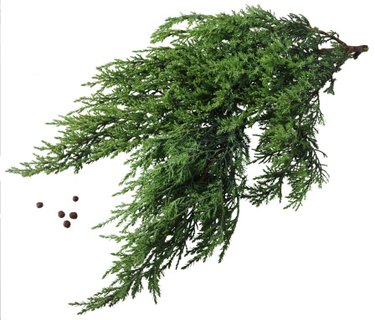Things You'll Need
Pruning shears
Fungicide
Spraying equipment

Cedar rust is a fungal disease of red cedar, which is a juniper (Juniperus virginiana), and other junipers. True cedars belong to the pine family (Pinaceae), while junipers and arborvitae belong to the Cupressaceae plant family. Red cedars and other junipers are most often infected by the cedar-apple rust fungus. Related rusts are cedar-hawthorn and cedar-quince rusts. The life cycle of these rusts require two different host trees. Cedar-apple rust needs a juniper and an apple or crabapple tree to complete its life cycle. Cedar-hawthorn and cedar-quince rusts have similar life cycles.
Step 1
Separate the two types of trees, such as junipers and apple trees. A distance of a few hundred feet will often prevent infection and break the life cycle of the cedar-apple rust fungus. However, because wind can spread fungal spores, trees could become infected even when separated by one-fourth mile to several miles, depending on the landscape. Cut down nearby junipers to protect apple and crabapple trees. Removing junipers will also break the life cycle of cedar-hawthorn and cedar-quince rust fungus.
Video of the Day
Step 2
Destroy the galls on junipers in late winter. In late summer, the cedar-apple rust fungus on infected apple or crabapple trees will form spores on the underside of leaves, which will be carried by wind and rain to susceptible junipers. The fungus will grow on juniper twigs, forming rounded galls. Cedar-hawthorn rust forms smaller galls, less than one inch, while cedar-quince rust forms large cylindrical galls. The galls may remain active for many years. Use pruning shears to remove juniper twigs with galls. Pruning off galls is a good option when only small junipers or few trees are involved.
Step 3
Use a fungicide to treat cedar rust fungus when the infection on apple trees or other host trees is severe or chronic. During wet periods in early May, orange, gelatinous horns develop on the galls of junipers. These horns produce spores that infect apple and other host trees. Start spraying when the apple tree begins to blossom. Spray every seven to 10 days while spores are being produced by the juniper galls. Select the appropriate fungicide and follow the instructions on the label or consult a professional tree service.
Step 4
Plant resistant trees. Planting cedar-apple rust resistant apple trees such as Dayton, Delicious, and William's Pride will prevent or reduce fungal infections by breaking the fungal life cycle. Many crabapple trees are very susceptible to the cedar-apple rust fungus, although resistant varieties are now available. You can also plant or replace diseased plants with cedar rust-resistant junipers and hawthorns.
Tip
You don't need to spray fungicide during warm, dry periods. The cedar rust fungus only infects during cool, wet weather.
Removing infected leaf and fruit litter on the ground helps reduce the spread of rust infections.
Warning
Cutting down red cedars, junipers and removing cedar galls on your own property will not help if your neighbor has host trees.
Video of the Day